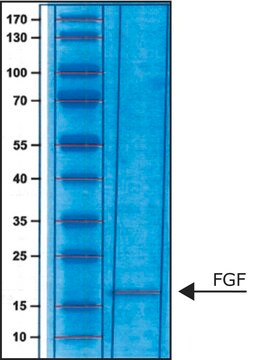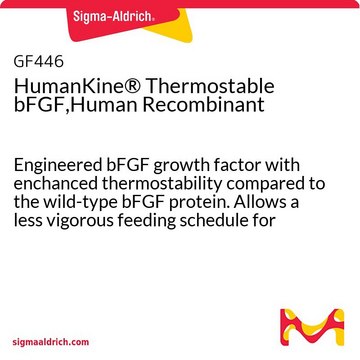F5392
Fibroblast Growth Factor-Basic from bovine pituitary
~90% (SDS-PAGE and N-terminal analysis), lyophilized powder, suitable for cell culture
Synonym(s):
FGF2, bFGF
About This Item
Recommended Products
product name
Fibroblast Growth Factor-Basic from bovine pituitary, FGF-Basic, suitable for cell culture
biological source
bovine pituitary glands
Quality Level
Assay
~90% (SDS-PAGE and N-terminal analysis)
form
lyophilized powder
potency
0.03-3.0 ng/mL ED50/EC50
quality
endotoxin tested
mol wt
16.4 kDa
packaging
pkg of 1 μg
storage condition
avoid repeated freeze/thaw cycles
technique(s)
cell culture | mammalian: suitable
impurities
<0.5 EU/vial
color
white
UniProt accession no.
storage temp.
−20°C
Gene Information
bovine ... FGF2(281161)
General description
Application
Fibroblast Growth Factor-Basic from bovine pituitary has been used:
- In animal and human cell culture
- In neuronal induction of adipose and bone marrow-derived rat mesenchymal stem cells
- In the generation of directly reprogramming fibroblast
- In human glioma cell culture
Biochem/physiol Actions
Physical form
Preparation Note
Analysis Note
related product
Storage Class Code
11 - Combustible Solids
WGK
WGK 3
Flash Point(F)
Not applicable
Flash Point(C)
Not applicable
Personal Protective Equipment
Certificates of Analysis (COA)
Search for Certificates of Analysis (COA) by entering the products Lot/Batch Number. Lot and Batch Numbers can be found on a product’s label following the words ‘Lot’ or ‘Batch’.
Already Own This Product?
Find documentation for the products that you have recently purchased in the Document Library.
Customers Also Viewed
Our team of scientists has experience in all areas of research including Life Science, Material Science, Chemical Synthesis, Chromatography, Analytical and many others.
Contact Technical Service








